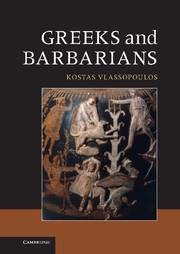Book contents
- Frontmatter
- Contents
- List of Maps and figures
- Acknowledgements
- Note to the reader
- List of Abbreviations
- 1 Introduction
- 2 The Panhellenic world and the world of empires
- 3 The world of networks and the world of apoikiai
- 4 Intercultural communication
- 5 The Barbarian repertoire in Greek culture
- 6 Globalisation and glocalisation
- 7 The Hellenistic world
- 8 Conclusions
- Bibliography
- Index locorum
- Index
3 - The world of networks and the world of apoikiai
Published online by Cambridge University Press: 05 June 2013
- Frontmatter
- Contents
- List of Maps and figures
- Acknowledgements
- Note to the reader
- List of Abbreviations
- 1 Introduction
- 2 The Panhellenic world and the world of empires
- 3 The world of networks and the world of apoikiai
- 4 Intercultural communication
- 5 The Barbarian repertoire in Greek culture
- 6 Globalisation and glocalisation
- 7 The Hellenistic world
- 8 Conclusions
- Bibliography
- Index locorum
- Index
Summary
A historical overview
Around 1000 bce the Mediterranean world gives a strongly parochial appearance. Within the Aegean, most people produced and consumed local products, with limited evidence for the exchange of goods, ideas and technologies across cultures; people mostly lived and died where they were born, there being little evidence for human mobility. This was not the primeval condition of a primitive world; it was the result of the breakdown of a highly interconnected Mediterranean world during the Late Bronze Age (1500–1200) . There is no better illustration of the interconnectedness of the Late Bronze Age Mediterranean than the bronze ingots in the shape of an oxhide, which can be found from Sardinia all the way to Cyprus and the Levant; the exchange of bronze had reached such levels that a standardised form in the shape of an oxhide was invented and widely adopted by various communities. But this was all gone by the year 1000 and the world looked radically different.
This image of a Mediterranean world of small, isolated communities was gradually modified. New networks moving people, goods, ideas and technologies were being established across the Mediterranean. Archaeology provides hard evidence for the movement of goods: by 800 Greek pottery could be found from the Levantine coast of the eastern Mediterranean to Sardinia and southern Italy in the western Mediterranean; metal ware, jewellery, seals, vases and statuettes made of faience and alabaster produced by Syrian and Phoenician craftsmen were to be found in the Aegean as well as in the waters of the western Mediterranean. Alongside the mobility of goods there was also the mobility of ideas and technologies. Many areas of the Mediterranean had never known the technology of writing, while in the Aegean the syllabic Linear B script vanished with the end of the Bronze Age world; during the eighth century the technology of alphabetic writing expanded all over the Mediterranean through the Greek adaptation of the Phoenician alphabet, which was subsequently adopted by other non-Greek cultures for their own languages (pp. 227–9). At the same time motifs, styles and iconographic elements from the artistic traditions of the Levant and northern Syria were being adopted and adapted in Greece as well as in the western Mediterranean. This mobility of goods, ideas and technologies was predicated on human mobility.
- Type
- Chapter
- Information
- Greeks and Barbarians , pp. 78 - 128Publisher: Cambridge University PressPrint publication year: 2013

